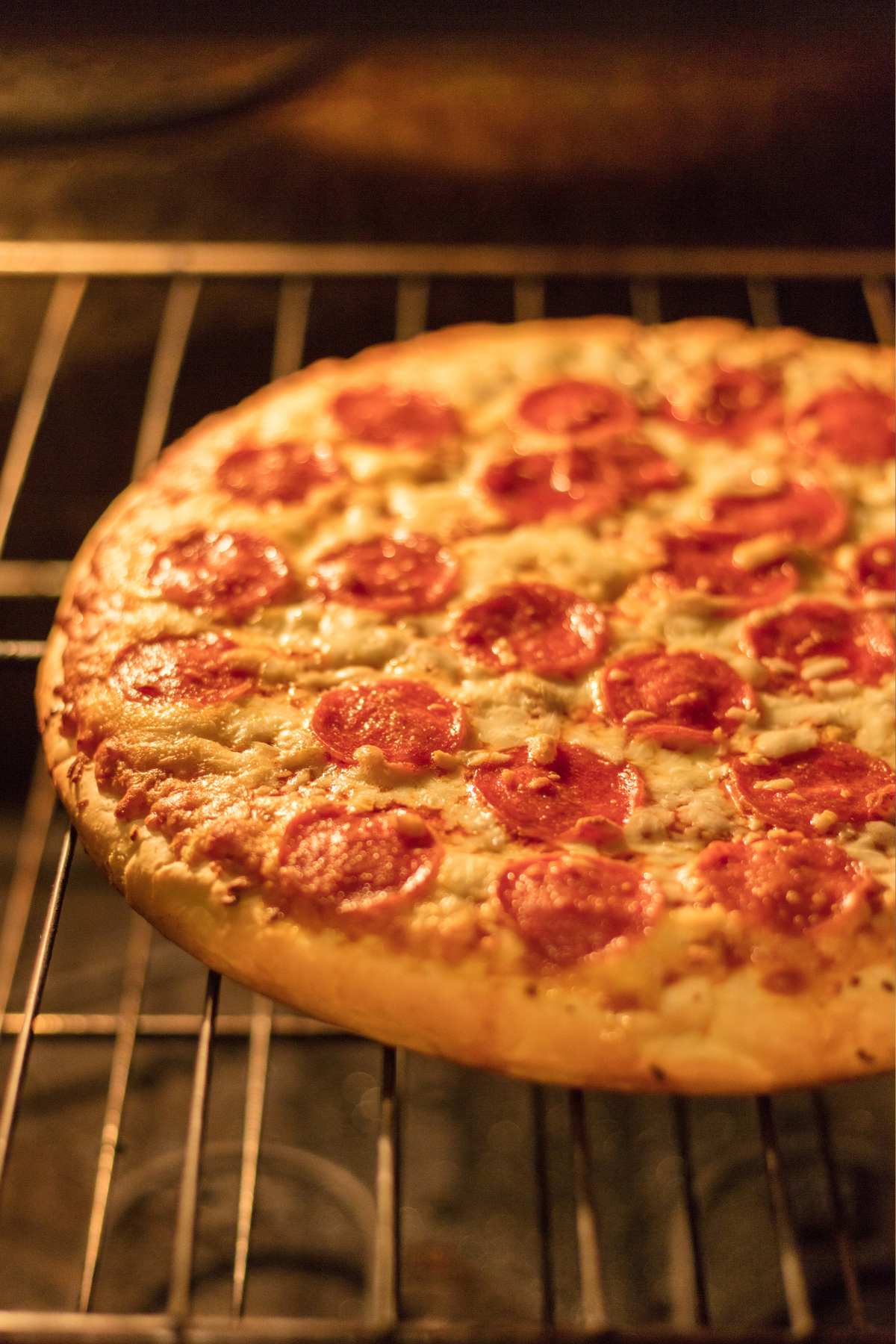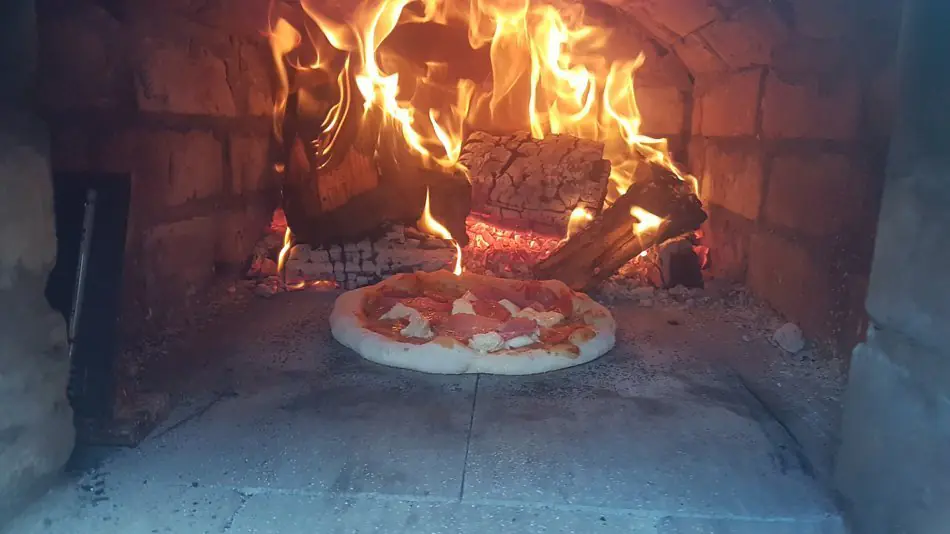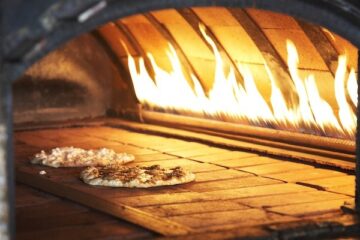A pizza oven can get as hot as 500°C (932°F) to cook pizzas quickly and achieve that perfect crispy crust. This high temperature allows for a short cooking time, producing a well-cooked pizza with a charred and blistered crust.
The intense heat also helps to melt and bubble the cheese while keeping the toppings and the base moist and flavorful. Cooking a pizza at such high temperatures is one of the key factors in replicating the authentic taste and texture of a traditional wood-fired oven.
The heat of the pizza oven is crucial in achieving that balance of crispy and chewy, along with the signature smoky flavor. A pizza oven can reach temperatures up to 500°C (932°F) to create the perfect pizza.

Credit: izzycooking.com
Understanding The Temperature Range Of Pizza Ovens
Understanding the temperature range of pizza ovens is crucial in achieving the perfect homemade pizza. Discover how hot a pizza oven can get and unlock the secrets to baking a delicious pie at the right temperature.
Pizza ovens are designed to reach high temperatures to ensure the perfect pizza cooking experience. The temperature range of pizza ovens can vary depending on the type of oven you choose. Let’s delve into the different types of pizza ovens and their temperature ranges:
Different Types Of Pizza Ovens
There are several types of pizza ovens available in the market. Here are a few popular ones:
- Electric pizza ovens:
- Temperature range: 400°F to 600°F
- These ovens are easy to use and perfect for home cooks who enjoy making pizzas occasionally.
- Gas pizza ovens:
- Temperature range: 500°F to 800°F
- These ovens provide a faster cooking time than electric ovens and are commonly used in pizzerias.
- Wood-fired pizza ovens:
- Temperature range: 700°F to 1000°F
- These traditional ovens offer an authentic flavor and are popular among pizza enthusiasts and professionals.
- Brick pizza ovens:
- Temperature range: 500°F to 800°F
- These ovens are made of bricks and have excellent heat retention properties, resulting in evenly cooked pizzas.
Temperature Range For Each Type Of Pizza Oven
Maintaining the right temperature is crucial for baking a perfect pizza. Here’s a breakdown of the temperature ranges for each type of pizza oven:
- Neapolitan-style pizza:
- Temperature range: 900°F to 1000°F
- This style requires a quick cooking time, resulting in a soft and slightly charred crust with melty toppings.
- New York-style pizza:
- Temperature range: 500°F to 550°F
- This style calls for a slightly longer cooking time, creating a crispier crust with a chewy texture.
- Neapolitan-style and New York-style pizzas can be cooked in wood-fired, gas, or electric ovens.
The Importance Of Maintaining The Right Temperature For Perfect Pizza
Achieving the perfect pizza goes beyond just great dough and fresh toppings. Maintaining the right temperature in your pizza oven is crucial. Here’s why:
- Proper crust development: The high temperature helps create a crispy outer crust while keeping the inner dough soft and chewy.
- Topping perfection: The intense heat from the oven ensures that your cheese melts evenly and your toppings cook perfectly.
- Faster cooking time: With the right temperature, your pizza will cook faster, resulting in a shorter waiting time and a hungry crowd satiated sooner.
- Flavor enhancement: The combination of high heat and the natural properties of different pizza ovens adds a unique smoky flavor to your pizza.
So, whether you’re a home cook or a professional chef, understanding the temperature range of your pizza oven and maintaining it correctly is essential for achieving that perfect slice of pizza.
Ideal Temperature For Different Pizza Styles
The ideal temperature for different pizza styles varies, but a pizza oven typically reaches temperatures as high as 900°F (482°C). This high heat helps create the perfect crispy crust and evenly cooked toppings for a delicious homemade pizza.
Neapolitan Pizza: The Traditional High Heat Requirement
Neapolitan pizza is known for its thin, soft, and chewy crust with a slightly charred bottom. Achieving the perfect Neapolitan pizza requires a pizza oven that reaches extremely high temperatures. Here’s what you need to know about the ideal temperature for Neapolitan pizza:
- The oven temperature: A traditional Neapolitan pizza oven needs to reach a scorching temperature of around 900°F (480°C). This high heat ensures the pizza cooks quickly, resulting in a beautifully blistered crust and perfectly melted cheese.
- Cooking time: Neapolitan pizzas only take about 90 seconds to cook due to the intense heat. This rapid cooking time helps maintain the dough’s softness while creating a charred outer layer.
- Charred crust: The high temperature gives the crust its signature charred spots, adding a delightful smoky flavor to the pizza.
New York-Style Pizza: Striking The Balance Between Heat And Crispiness
New York-style pizza is known for its wide slices, foldability, and crispy yet chewy crust. To achieve the perfect balance of crispy and chewy, the ideal temperature for New York-style pizza differs from that of Neapolitan pizza. Here’s what you need to know:
- The oven temperature: For New York-style pizza, the temperature should be around 500-550°F (260-290°C). This temperature allows the pizza dough to cook thoroughly and develop a crispy golden crust.
- Cooking time: New York-style pizzas typically cook 10-15 minutes. The slightly lower temperature and longer cooking time than Neapolitan pizza result in a sturdier crust with a satisfying crunch.
- Even heat distribution: To achieve the perfect New York-style pizza, ensure your oven provides even heat distribution to ensure consistent browning and avoid burnt or undercooked spots.
Thin Crust Pizza: Lower Temperature For A Crispy Base
Thin-crust pizzas are popular for those who prefer a lighter and crisper pizza experience. Here’s how you can achieve the ideal temperature for baking thin-crust pizzas:
- The oven temperature: To achieve a crisp base while keeping the toppings properly cooked, set the oven temperature to around 450-475°F (230-245°C). This lower temperature allows the dough to cook gradually while still achieving the desired level of crispness.
- Cooking time: Thin crust pizzas usually take 10-12 minutes to bake. The slightly longer baking time compared to New York-style pizza ensures that the dough cooks all the way through without becoming too crunchy or chewy.
- Toppings ratio: Since thin-crust pizzas cook relatively quickly, it’s essential to ensure that the toppings are thinly sliced and evenly distributed to prevent them from burning or overcooking.
Deep-Dish Pizza: A Lower And Longer Cooking Temperature
Deep-dish pizzas are characterized by their thick and doughy crust, loaded with layers of cheese, sauce, and toppings. To achieve the ideal temperature for baking deep-dish pizzas, follow these guidelines:
- The oven temperature: Set the oven temperature to around 375-400°F (190-205°C) for deep-dish pizzas. The lower temperature and longer cooking time allow the thick dough to cook through without burning the top layer.
- Cooking time: Deep-dish pizzas generally take 25-30 minutes to bake. The extended cooking time ensures that the dense dough is fully cooked and the cheese is melted and bubbly.
- Pie pan insulation: To avoid a soggy crust, consider preheating the pie pan before adding the dough. This helps create a crispy layer on the bottom of the deep-dish pizza.
Wood-Fired Vs. Gas-Fired Oven Temperatures: Pros And Cons
Regarding pizza ovens, there are two popular options: wood-fired and gas-fired. Each has its temperature advantages and considerations. Here’s a comparison of the pros and cons:
Wood-fired oven:
- Pros:
- It can reach exceptionally high temperatures, perfect for Neapolitan pizzas.
- Provides a smoky and distinct flavor to the pizza.
- Creates a rustic and authentic cooking experience.
- Cons:
- Requires additional time for preheating and wood-fueled maintenance.
- Requires a steady supply of wood for fuel.
- Limited temperature control compared to gas-fired ovens.
Gas-fired oven:
- Pros:
- Offers precise temperature control, making it easier to achieve consistent results.
- Faster preheating time compared to wood-fired ovens.
- Convenient and easy to use.
- Cons:
- It may need a more distinct smoky flavor of wood-fired pizzas.
- Limited technology or design options compared to wood-fired ovens.
- Tends to cost more to buy and install.
Remember, the temperature you choose for your pizza oven is crucial in achieving the perfect pizza crust and overall taste. Understanding the ideal temperatures for different pizza styles allows you to experiment and craft your delicious pizzas at home.
Factors Influencing Pizza Oven Temperature
Pizza oven temperatures can reach as high as 900°F (500°C) to achieve the perfect crisp and gooey pizza. Factors influencing the temperature include the type of pizza oven, fuel used, and preheating time.
Regarding pizza oven temperatures, several factors can influence how hot the oven gets. These factors include the type of fuel used, oven insulation and construction materials, oven size and chamber volume, oven preheating time, and heat retention.
Let’s take a closer look at each of these factors:
Type Of Fuel Used (Wood, Gas, Electric):
- Wood: Wood-fired pizza ovens are known for reaching extremely high temperatures, usually between 800°F and 1000°F. Wood combustion produces intense heat, giving pizzas that coveted crispy crust and smoky flavor.
- Gas: Gas-powered pizza ovens offer more control over the temperature. They typically reach temperatures between 500°F and 700°F and provide consistent heat for baking pizzas quickly and evenly.
- Electric: Electric pizza ovens are convenient and easy to use. They usually have a maximum temperature of around 500°F to 600°F, sufficient for baking delicious pizzas at home.
Oven Insulation And Construction Materials:
- Insulation: A well-insulated pizza oven can retain heat more effectively, allowing it to reach and maintain higher temperatures. Insulation materials such as ceramic fiber blankets or refractory materials help prevent heat loss and ensure consistent cooking temperatures.
- Construction materials: The materials used in the oven’s construction can impact its ability to reach high temperatures. Clay, brick, or refractory concrete ovens are common choices for traditional wood-fired pizza ovens due to their excellent heat retention properties.
Size And Chamber Volume for Oven:
- Oven size: The size of the pizza oven affects its heat-up time and overall temperature. Smaller ovens tend to heat up faster but may need help maintaining the same high temperature as larger ovens due to limited heat retention.
- Chamber volume: The chamber volume refers to the interior space of the pizza oven. A larger chamber volume allows for better heat circulation, resulting in more even baking and higher temperatures.
Oven Preheating Time And Heat Retention:
- Preheating time: Before you start cooking, it’s important to preheat your pizza oven adequately. Wood-fired ovens require a longer preheating time compared to gas or electric ovens. Preheating can take 1 to 2 hours, depending on the type of pizza oven and desired temperature.
- Heat retention: The ability of the pizza oven to retain heat ensures consistent cooking temperatures. Well-insulated ovens with high-quality materials tend to have better heat retention capabilities, allowing them to reach and maintain higher temperatures for extended periods.
Considering these factors, you can choose the right pizza oven and understand how they achieve their desired temperatures. Whether you prefer the traditional charm of a wood-fired oven or the convenience of a gas or electric oven, you’ll be able to enjoy delicious homemade pizzas with a perfectly cooked crust every time.
Tips For Achieving And Maintaining The Perfect Pizza Oven Temperature
Tips for achieving and maintaining the perfect pizza oven temperature without sacrificing flavor. Learn how hot a pizza oven can get and the best practices to ensure a delicious homemade pizza every time.
Properly Preheating Your Pizza Oven:
- Preheating your pizza oven is crucial for achieving the perfect temperature. Here are some tips to ensure a proper preheating process:
- Use dry, seasoned hardwood or charcoal to build a fire in your pizza oven.
- Allow enough time for the fire to fully catch and reach its peak temperature, usually around 700-900 degrees Fahrenheit.
- Monitor the temperature using an oven thermometer (more on this in the next section).
Using A Reliable Oven Thermometer:
- A reliable oven thermometer is essential for accurately measuring the temperature of your pizza oven. Here’s why you should invest in one:
- Place the oven thermometer inside your pizza oven for an accurate temperature reading.
- Ensure the thermometer is easily readable and positioned in the center of the oven for optimal results.
- Monitor the thermometer throughout the cooking process to ensure consistent temperature maintenance.
Techniques To Maintain Consistent Temperature During Cooking:
- Maintaining a consistent temperature throughout cooking is key to baking the perfect pizza. Here are some techniques to help you achieve this:
- Adjust the fuel or fire intensity amount based on the temperature readings from your oven thermometer.
- Use the oven door to regulate the heat. Leave it slightly open to release excess heat or close it partially to retain more heat.
- Rotate the pizza periodically to ensure even cooking and prevent hot spots.
- Avoid opening the oven door too frequently, which can cause temperature fluctuations.
Adjusting Temperature For Multiple Pizza Batches:
- If you plan to bake multiple pizza batches, adjusting the temperature is important. Here’s how to do it:
- Allow the oven temperature to recover after each batch by adding more fuel or adjusting the fire intensity.
- Use the oven thermometer to monitor the temperature and make necessary adjustments to maintain consistent heat.
- Give the oven a few extra minutes to reach the desired temperature before adding the next batch of pizzas.
Remember, achieving and maintaining the perfect pizza oven temperature requires careful attention to detail. By properly preheating your oven, using a reliable thermometer, implementing temperature maintenance techniques, and adjusting for multiple pizza batches, you’ll be on your way to creating delicious homemade pizzas that rival your favorite pizzeria.
Now, let’s fire up that oven and get cooking!
Frequently Asked Questions About Pizza Oven Temperature
Discover the ideal temperature for your pizza oven with frequently asked questions about pizza oven temperature. Explore how hot a pizza oven gets and why it needs to reach such high temperatures for the perfect crispy crust and melty cheese.
Can A Regular Oven Achieve The Same Temperature As A Pizza Oven?
- Regular ovens typically can reach a different high temperature than pizza ovens.
- Most regular ovens have a maximum temperature of around 500°F (260°C), while pizza ovens can reach temperatures of up to 900°F (480°C).
- The high temperature in a pizza oven is essential for achieving that perfectly crispy crust and quick cooking time.
What Happens If The Oven Temperature Is Too Low/High?
- If the oven temperature is too low, the pizza may take longer, resulting in a soggy crust and unevenly melted cheese.
- On the other hand, if the oven temperature is too high, the pizza can quickly burn outside while still being undercooked on the inside.
- Finding the right balance and following the recommended temperature guidelines for optimal pizza cooking is crucial.
Can You Use A Pizza Stone Or Steel In A Regular Oven To Achieve Similar Results?
- Yes, you can use a pizza stone or steel in a regular oven to achieve similar results to a pizza oven.
- A pizza stone or steel helps to absorb and distribute heat evenly, resulting in a crispier crust.
- Preheating the stone or steel in the oven before placing the pizza on it is essential for optimal results.
Is There An Optimal Temperature For Cooking Frozen Pizzas?
- The optimal temperature for cooking frozen pizzas varies depending on the brand and type of frozen pizza.
- Generally, the recommended temperature falls between 375°F (190°C) and 425°F (218°C).
- It is essential to follow the packaging instructions for the most effective results.
Always preheat your oven properly and adjust the cooking time based on the temperature guidelines provided by the pizza brand or recipe. Achieving the right temperature in your pizza oven is crucial for delicious, restaurant-quality pizzas at home.
Frequently Asked Questions Of How Hot Does A Pizza Oven Get
A wood-fired pizza oven can reach temperatures as high as 900°F.
Pizza ovens are hotter than regular ovens, reaching temperatures up to 900°F (482°C).
OONI pizza ovens can reach a temperature of 950°F (or 500°C).
A pizza oven can reach temperatures as high as 500°C in Celsius.
Conclusion
To achieve the most delicious pizza, it’s crucial to understand how hot a pizza oven can get. The temperature plays a significant role in ensuring a crispy crust and perfectly melted cheese. Pizza ovens can reach incredibly high temperatures, often exceeding regular household ovens.
Wood-fired pizza ovens, for instance, can reach temperatures up to 900°F or 500°C. These intense temperatures are necessary to achieve a wood-fired pizza’s desired flavor and texture. The application of elevated temperatures facilitates rapid cooking of the crust, developing a crisp outer layer and a tender, resilient inner texture.
In comparison, traditional home ovens typically reach temperatures of only 550°F, which may not be hot enough to replicate the authentic taste of a wood-fired pizza. A pizza stone or baking steel can help elevate the temperature in a regular oven to achieve better results.
Understanding how hot a pizza oven can get is essential for all enthusiasts. It empowers us to make informed decisions regarding the type of oven we choose and the techniques we employ to create the perfect homemade pizza. So whether you’re using a wood-fired oven or a regular oven with additional tools, knowing the optimal temperature is the secret to the best pizza experience.

As the author of the “Ultimate Pizza Guide: Recipes, Tips & Secrets Revealed,” I’m dedicated to sharing my love for pizza and empowering others to create delicious homemade pizzas with ease. Join me on a journey to uncover the secrets to perfecting your pizza game!



